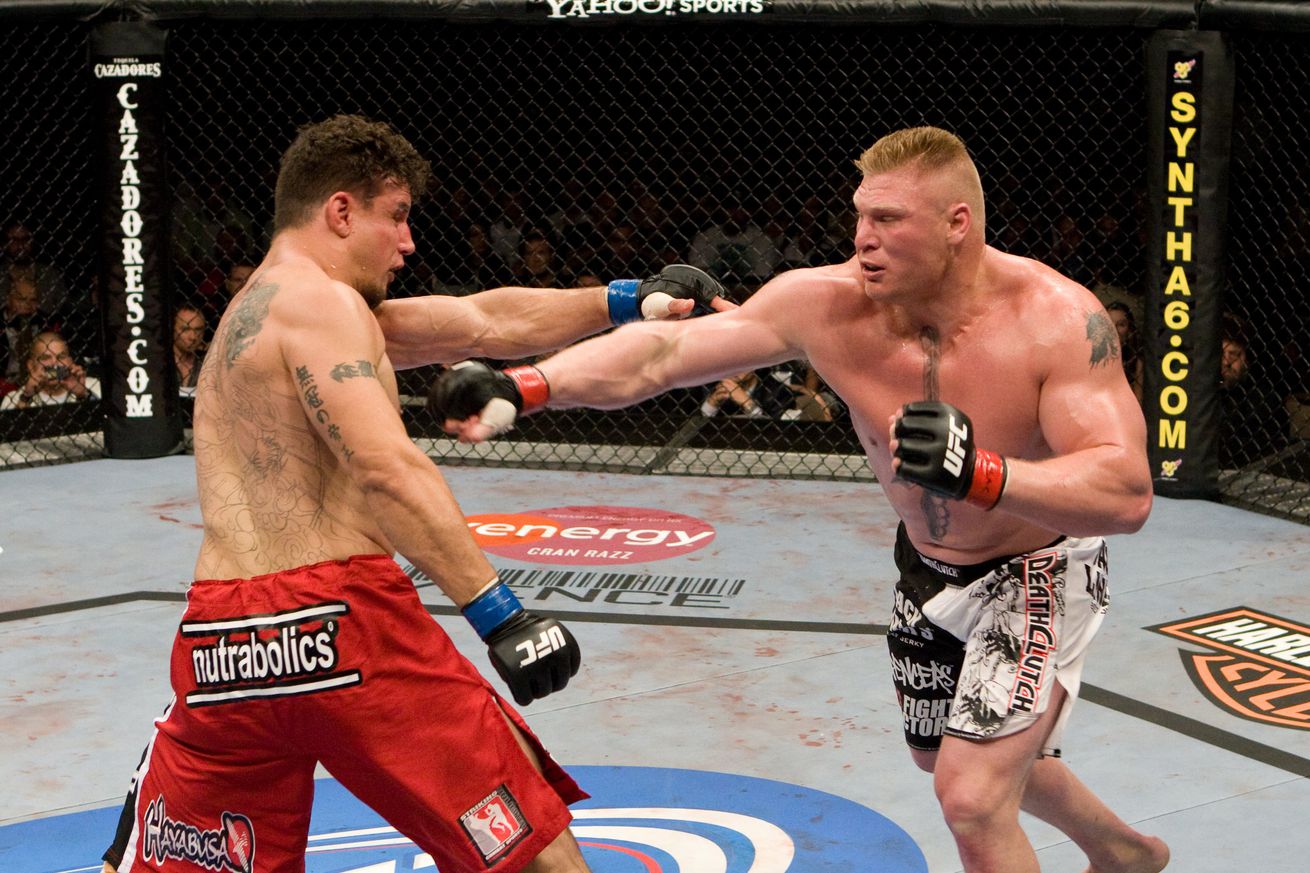Frank Mir didn’t realize until years later how drastically underpaid he was for fighting Brock Lesnar at UFC 100

Frank Mir doesn’t want to seem like a sore loser. But he can’t help but wonder who really got paid from one of the UFC’s most successful cards of all-time — because it definitely wasn’t him.
Promoted as a historic event, UFC 100 took place in 2009 and featured a blockbuster main event between champ Mir and WWE superstar turned fighter Brock Lesnar. The event sold 1.6 million pay-per-views — a record-setting number at the time — and at a cost of $44.95, it produced over $71 million in revenue.
Back then, the UFC split pay-per-view profits with cable and satellite companies. Typically, that cut its revenue in half. For UFC 100, the promotion likely earned around $35 or $36 million. Meanwhile, salaries for the event, which were publicly available at that time, showed Mir made $45,000 for his loss, while Lesnar earned $400,000. That was before pay-per-view sales were factored in.
Mir said that even with his bonus, he didn’t clear $1 million for his fight with Lesnar – or any other fight during his 15-year career with the UFC. It wasn’t until years later he realized how drastically underpaid he was compared to the UFC’s profits.
“I think when it finally dawned on me was the Deontay Wilder [rematch] with Tyson Fury,” Mir told MMA Fighting. “We still did more buys than they did, me and Brock, and then I’m looking at the pay-per-view cost. OK, the money was there. Who did it go to?
“Seeing these guys make $40 million combined. I’m like wow. Brock obviously made seven figures off it, I think he made $2.5 million. But I didn’t even make a million.”
The Fury vs. Wilder 2 card in 2020 reportedly sold between 800,000 and 850,000 buys at a price of $79.99 on pay-per-view. By those metrics, the boxing match likely earned somewhere around $66 million. Fury and Wilder were both guaranteed to make more than $25 million, plus a share of the pay-per-view profits.
That’s a whole lot more than Mir took home as part of a UFC card that sold 1.6 million buys. He said Lesnar even deserved more than he got after clearing $2.5 million from the event.
“Brock himself, a much bigger superstar than [Fury or Wilder],” Mir said. “How come he wasn’t making $20 million? That blows my mind, and I don’t understand it. “Until Conor [McGregor] came along, we had the record for the most pay-per-view buys sold.”
As much as he laments the paltry payday he received for UFC 100, Mir admits he didn’t have a great understanding about the money he made compared to the lion’s share of the profits the promotion took home. Years later, he acknowledges the salary he earned from the UFC didn’t come anywhere near what he should have been making, and it was an incredibly costly lesson.
“At the time, I didn’t know better,” Mir said. “We didn’t know. Just now as time goes on, I’m looking around like, hold on a second, that makes no sense. A pay-per-view buy is a pay-per-view buy. Why is this sport paying their athletes this percentage of what they’re making versus this one? It’s the pretty same makeup. This isn’t two wildly different sports, boxing and MMA. They’re very comparable when it comes to putting up a cage or a ring, so it’s not like the costs are different.
“So what’s the difference here? Oh, that’s because you have competing promoters, and they know what’s going on, and you can’t screw each other. In the UFC, it’s the only promoter. In MMA, the show is the only promoter. It’s not like we’re going to have a Bellator fighter and a UFC fighter, and they’re both on the card, so both organizations know what they’re going to get their guy, because they both understand the revenue models. They understand what’s going on. They’re not speaking from ignorance.”
Even though UFC pay continues to be a hot topic among fighters, Mir admits athletes are making more money now than 15 years ago, when he fought Lesnar. That’s the only thing that calms his nerves when it comes to his daughter Bella followed in her father’s footsteps by fighting.
“I’m not as uneasy about it,” Mir said. “Before, it was like I don’t know that many people who do MMA and don’t still have to do something afterward. Myself included. Doing commentary, working for different groups and organizations. There’s a reason why I’m busy. To know she can make a career and a living off it too, it makes that pill a little easier to swallow.
“As the father in me, I’m like OK, she’s going to be millionaire at least. I’m not as scared about it as I was before. Because you have the risk of injury, and you’re not going to be pursuing other endeavors in life that could take care of you financially, and you’re going to sacrifice that to follow this fight career, and then you’re going to be behind when you go into those careers.
“For what? For personal gain, for martial arts and pushing yourself is awesome, but as a father, it’s like what about your bank account? Your security. Are you going to be able to take care of yourself? At the time, I was terrified. Now, not so much. It’s a better world now than when I was there.”
